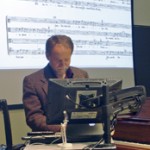In summer 2014, Ensemble was introduced as Rice’s new resource management system. Ensemble replaces a collection of tools that had grown unwieldy. Two distinct audiences need to access digital film clips at Rice: (1) faculty and students use digital media clips in their courses and (2) the general public is interested in videos of special events, from guest speakers to graduation ceremonies. An excellent way to explore a Rice web page that currently uses Ensemble to group and display media assets is http://mediahub.rice.edu, the portal for university events recorded by the Educational Productions team.
Why Use Movie or Audio Clips?
Rice professors often use a supplemental reading list as a class resource and they reference excerpts from the texts in lectures, class discussions or homework assignments. An increasing amount of multi-media resources have been drawn into Rice classes and media playlists may supplement or replace traditional reading lists. Audio and video lists, also known as playlists, are easily included in Rice course sites in OWL-Space. In a previous IT News article, Dr. Peter Lowen described loading audio files for students to listen to while reading they read the composer’s score.
In addition to digital clips from externally produced films, some Rice instructors include video capture recordings of their classroom presentations; other faculty create self-recorded videos of their lectures, lab techniques, and other demonstrations. Rice students can also be asked to create videos as assignments. For example, students in one course were required to show their understanding of a topic by recording a video of their explanation. The videos were submitted only to the instructor and the instructor graded videos rather than papers. In the HUMA 300 course –part of the Poverty, Justice and Human Capabilities minor– instructor Anne Dayton used peer reviews of student-created videos and images. The videos and images were uploaded to a private blog for review by other students in the class, instead of being submitted only to the instructor.
Organizing Media Assets
Obviously, instructors using a lot of videos also need a tool that allows them to organize the many digital media assets they are accumulating. The organizational tool must work well with OWL-Space, the university’s learning management system. As early as 2011, IT’s Academic Technology Services (ATS) team began searching for a solution that could group digital media assets by common themes, display images or readings associated with a particular film, and provide an area beside the clip for comments. The solution needs a student submission process, one that can be customized to meet the instructor’s plans for the student videos. For example, an instructor using student videos for peer review discussions requires an automated and immediate publishing process so the rest of the class can quickly watch and comment on the new clips. However, the faculty member who is requiring video submissions for a grade might prefer a moderated process, which allows the instructor to select which videos to share with the rest of the class.
Ensemble works well with OWL-Space, but it also easily supports media assets that are frequently viewed by the public. For information on using Ensemble in a Rice course or in conjunction with departmental web sites, contact the ATS team at academictech@rice.edu.


